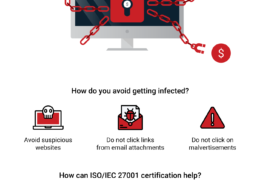Organizations can take several steps to protect against ransomware attacks: Regular Backups: Implement frequent backups of critical data and store them offline or in a secure cloud environment. Ensure backups are tested regularly for integrity. Software Updates: Keep all systems, applications, and aRead more
Organizations can take several steps to protect against ransomware attacks:
Regular Backups: Implement frequent backups of critical data and store them offline or in a secure cloud environment. Ensure backups are tested regularly for integrity.
Software Updates: Keep all systems, applications, and antivirus software up to date with the latest patches and security updates to protect against vulnerabilities.
Security Training: Educate employees about phishing scams and other common attack vectors. Regular training can help employees recognize and avoid potential threats.
Access Controls: Implement strict access controls and permissions. Limit user privileges to only what is necessary for their roles, and use multi-factor authentication where possible.
Network Security: Use firewalls, intrusion detection systems, and secure network configurations to prevent unauthorized access. Regularly monitor network traffic for unusual activity.
Incident Response Plan: Develop and test an incident response plan that outlines procedures for dealing with ransomware attacks and other security incidents. Ensure all staff are aware of their roles in this plan.
Vulnerability Management: Regularly scan for and address vulnerabilities within your systems and applications. This includes applying security patches and updates promptly.
Email Filtering: Implement email filtering solutions to detect and block malicious attachments and links before they reach the users.
See less

A Distributed Denial of Service (DDoS) attack is a malicious attempt to disrupt the normal traffic of a targeted server, service, or network by overwhelming the target or its surrounding infrastructure with a flood of internet traffic. Here’s an in-depth look at what DDoS attacks are and how they caRead more
A Distributed Denial of Service (DDoS) attack is a malicious attempt to disrupt the normal traffic of a targeted server, service, or network by overwhelming the target or its surrounding infrastructure with a flood of internet traffic. Here’s an in-depth look at what DDoS attacks are and how they can be mitigated:
What is a DDoS Attack?
See lessCharacteristics of DDoS Attacks:
Distributed Nature: Unlike a standard Denial of Service (DoS) attack, which originates from a single source, a DDoS attack uses multiple compromised computers (often referred to as a botnet) to flood the target with traffic.
Volume-Based Attacks: These aim to consume the bandwidth of the target, such as UDP floods, ICMP floods, and other spoofed-packet floods.
Protocol Attacks: These focus on exploiting server resources by consuming connection state tables present in network infrastructure components like load balancers, firewalls, and application servers. Examples include SYN floods, fragmented packet attacks, Ping of Death, and Smurf DDoS.
Application Layer Attacks: These are more sophisticated and target-specific applications with the aim to exhaust the resources of the target. Examples include HTTP floods, Slowloris, and DNS query floods.
How to Mitigate DDoS Attacks
1. Network Infrastructure and Design
Over-Provisioning: Ensuring that your network can handle more traffic than it typically experiences can help absorb some of the excess traffic during an attack.
Load Balancing: Distributing incoming traffic across multiple servers can prevent a single server from being overwhelmed.
2. Traffic Analysis and Filtering
Traffic Filtering: Implementing filtering mechanisms to block malicious traffic. For instance, firewalls and Intrusion Prevention Systems (IPS) can block traffic from suspicious IP addresses.
Rate Limiting: Setting limits on the number of requests a server will accept over a certain period can help mitigate the impact of DDoS attacks.
3. DDoS Mitigation Services
Cloud-Based DDoS Protection: Services like Cloudflare, Akamai, and Amazon AWS Shield can absorb large volumes of attack traffic, distributing the load across their infrastructure.
Content Delivery Networks (CDNs): Using CDNs to cache content and serve it from multiple locations can reduce the load on the origin server.
4. Redundancy and Failover Strategies
Redundant Systems: Deploying systems in a geographically distributed manner ensures that if one data center is attacked, others can take over.
Failover Mechanisms: Automatic failover to backup systems can maintain service availability during an attack.
5. Behavioral Analysis and Machine Learning
Anomaly Detection: Implementing machine learning algorithms that learn normal traffic patterns and detect anomalies indicative of DDoS attacks.
Adaptive Filtering: Using AI to dynamically adjust filtering rules based on ongoing traffic patterns.
6. Collaboration with ISPs
Traffic Scrubbing: Working with Internet Service Providers (ISPs) to filter malicious traffic upstream before it reaches the target network.
7. Preparation and Response Plans
Incident Response Plans: Having a detailed and tested incident response plan in place can help organizations react quickly to mitigate the impact of a DDoS attack.
Regular Drills: Conducting regular DDoS attack simulations to ensure that staff are prepared and systems are configured correctly.
Conclusion
Mitigating DDoS attacks requires a multi-layered approach that combines robust network infrastructure, advanced traffic filtering techniques, collaboration with third-party services, and continuous monitoring and preparedness. By implementing these strategies, organizations can better protect themselves against the significant disruptions caused by DDoS attacks.